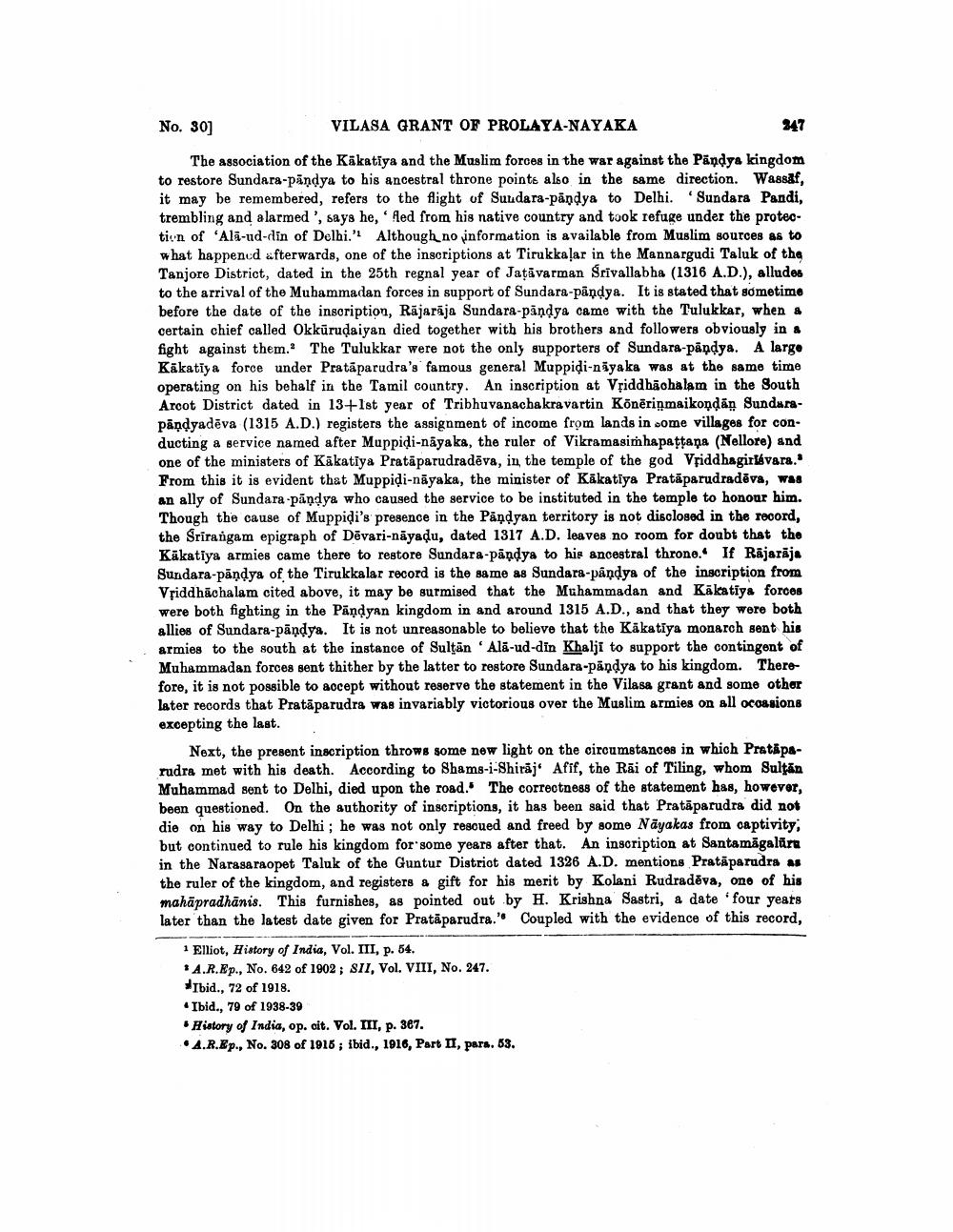________________
No. 30]
VILASA GRANT OF PROLAYA-NAYAKA
247
The association of the Kakatiya and the Muslim forces in the war against the Pandya kingdom to restore Sundara-pandya to his ancestral throne points also in the same direction. Wassaf, it may be remembered, refers to the flight of Suudara-pandya to Delhi. "Sundara Pandi, trembling and alarmed', says he, Aed from his native country and took refuge under the protection of 'Ala-ud-din of Delhi.': Although no information is available from Muslim sources as to what happened afterwards, one of the inscriptions at Tirukkaļar in the Mannargudi Taluk of the Tanjore District, dated in the 25th regnal year of Jatavarman Srivallabha (1316 A.D.), alludes to the arrival of the Muhammadan forces in support of Sundara-pandya. It is stated that sometimo before the date of the inscription, Rājarāja Sundara-pandya came with the Tulukkar, when & certain chief called Okkūrudaiyan died together with his brothers and followers obviously in a fight against them. The Tulukkar were not the only supporters of Sundara-pāņdya. A large Kākatiya force under Pratāparudra's famous general Muppidi-niyaka was at the same time operating on his behalf in the Tamil country. An inscription at Vșiddhãohalam in the South Arcot District dated in 13+1st year of Tribhuvanachakravartin Kõnēriņmaikondan Sundarapāņdyadēva (1315 A.D.) registers the assignment of income from lands in some villages for conducting a service named after Muppidi-nayaka, the ruler of Vikramasimhapattana (Nellore) and one of the ministers of Kakatiya Pratāparudradēva, in the temple of the god Vriddhagirlávara." From this it is evident that Muppidi-nayaka, the minister of Kākatiya Pratāparudradēva, was an ally of Sundara pandya who caused the service to be instituted in the temple to honour him. Though the cause of Muppidi's presence in the Pāņdyan territory is not disclosed in the record, the Srirangam epigraph of Dēvari-nāyadu, dated 1317 A.D. leaves no room for doubt that the Kakatiya armies came there to restore Sundara-pāņdya to his ancestral throne. If Rājarāja Sundara-pāņdya of the Tirukkalar record is the same as Sundara-pândya of the inscription from Vriddhachalam cited above, it may be surmised that the Muhammadan and Kakatiya forces were both fighting in the Pandyan kingdom in and around 1315 A.D., and that they were both allies of Sundara-pandya. It is not unreasonable to believe that the Käkatiya monarch sent his armies to the south at the instance of Sultan Ala-ud-din Khalji to support the contingent of Muhammadan forces sent thither by the latter to restore Sundara-pandya to his kingdom. Therefore, it is not possible to accept without reserve the statement in the Vilasa grant and some other later records that Pratäparudra was invariably victorious over the Muslim armies on all ocossions excepting the last.
Next, the present inscription throws some new light on the circumstances in which Prataparudra met with his death. According to Shams-i-Shirăj' Afif, the Rãi of Tiling, whom Sulţăn Muhammad sent to Delhi, died upon the road. The correctness of the statement has, however, been questioned. On the authority of inscriptions, it has been said that Prataparudra did not die on his way to Delhi; he was not only rescued and freed by some Näyakas from captivity, but continued to rule his kingdom for some years after that. An inscription at Santamägalare in the Narasaraopet Taluk of the Guntur District dated 1326 A.D. mentions Pratāparadra as the ruler of the kingdom, and registers & gift for his merit by Kolani Rudradēva, one of his mahapradhānis. This furnishes, as pointed out by H. Krishna Sastri, a date 'four years later than the latest date given for Pratāparudra.' Coupled with the evidence of this record,
1 Elliot, History of India, Vol. III, p. 54. * A.R.Ep., No. 642 of 1902; SII, Vol. VIII, No. 247.
Ibid., 72 of 1918. * Ibid., 79 of 1938-39
History of India, op. cit. Vol. III, p. 307. • A.R.Ep., No. 308 of 1916 ; ibid., 1916, Part II, pars. 63.




